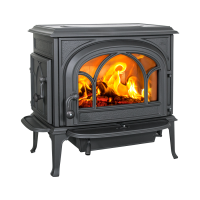8
139681_R06 F 500 Oslo 1/20
5.0 Operation
Please read the following section completely before
building a fire in your new Jøtul F 500.
5.1 Combustion Efficiency
The Jøtul F 500 has an EPA tested High Heating Value
(HHV) efficiency rate of 73.94. There are, however,
aspects of efficiency that you should be aware of
in order to get the most from your stove. Operation
habits and fuel moisture can have a significant
effect on efficiency. Poorly seasoned wood having a
higher than optimum moisture content, can reduce
the amount of energy transferred to the living area
as a result of the energy expended to evaporate
the excess fuel moisture in order for the wood to
burn. Operational habits - such as not building a
robust kindling fire to readily ignite the larger fuel
pieces - can result in an inefficient, smoldering fire.
Additionally, most modern wood heaters’ optimum
performance and efficiency are at the medium to
medium-low burn rates.
The location of the stove can also have a significant
effect on heating efficiency, primarily in regard to
distribution of the heat. For example, a wood heater
centrally located in an open living area, will likely
provide better circulation of heat than will a stove
located in a room adjacent to the larger living area.
5.2 Minimize Carbon Monoxide Emissions
Testing the F 500 to CSA B414.1-10 resulted in a carbon
monoxide emission rate of 112.22 grams per hour.
There are aspects of CO generation that you should
be aware of. Most all means of combustion produce
CO, including wood fires. You can greatly reduce CO
levels by maintaining a well-established fire and
avoiding operation that produces a smouldering,
smoky fire. We highly recommend that a CO monitor
(detector) be installed in the same room as the stove.
The monitor should be located as far away as possible
from the stove to avoid alerts when the doors are
opened.
5.3 Wood Fuel and Performance
The F 500 is designed to burn natural wood only.
Higher efficiencies and lower emissions generally
result when burning air-dried, seasoned hardwoods,
as opposed to softwoods, green or freshly cut
hardwoods. Wood that has been air-dried for a period
of 6 to 14 months will provide the cleanest, most
efficient heat. Wood seasoned more than 2 years will
burn too quickly to take advantage of the stove’s low
end efficiency strength.
A seasoned log will have check marks on the ends
and be lighter than an unseasoned log which will
show little or no check marks.
We recommend using a moisture meter to
determine the moisture content of your wood. For
purposes of home heating, your fuel should have
a moisture content between 12 - 20%. Wood with
higher moisture content will burn, however, very
inefficiently. Most of its heat value will be lost to
driving water out of the wood. Worse, that moisture
will condense as creosote in the relatively cool
chimney flue, increasing the potential for a chimney
fire. Use of unseasoned wood defeats the purpose of
any modern wood-burning stove.
DO NOT BURN:
• Coal;
• Garbage;
• Synthetic fuel or logs;
• Material containg rubber, including tires;
• Material containing plastics;
• Waste petroleum products, asphalt products, paints,
paint thinners or solvents;
• Materials containing asbestos;
• Construction or demolitioin debris;
• Railroad ties or pressure-treated wood;
• Manure or animal remains;
• Salt water driftwood or other previously salt-water;
saturated materials;
• Unseasoned wood; or
• Paper products, cardboard, plywood, or particle
board. (The prohibition against burning these
materials does not prohibit the use of fire starters
made from paper, cardboard, saw dust, wax or similar
substances for the purpose of starting a fire.)

